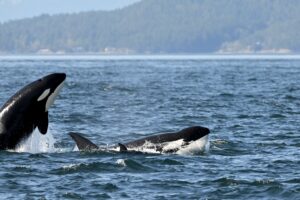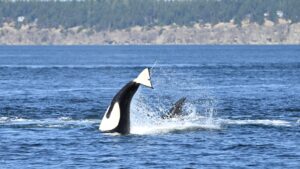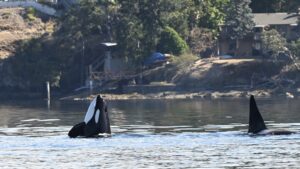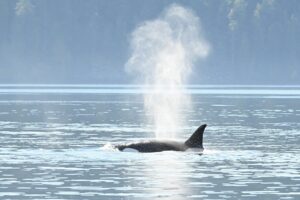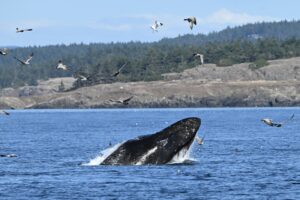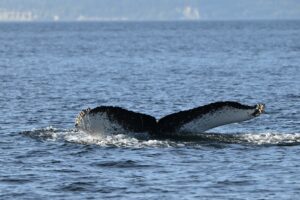As we bid adieu to summer, and as I write this on the fall equinox, I have definitely noticed that our trips out on the water this past week have felt a little different. The morning and the late afternoon air is chilly, and before we’re done cleaning up from our evening trips out, it’s dark. It’s been an unbelievable summer season and we’re still delighting in the whales and wildlife that are here for all of the Salish Sea’s resources. The late-in-the-day, golden hour lighting that we experience in September brings its own magic and I’m very interested to see which humpbacks begin passing through the islands as they start their migrations south. It’s possible that some of the Bigg’s killer whale families we haven’t seen for several months may also make passes into our area.
Bigg’s killer whale families that were encountered on our tours this week were: T36A1s (2), brothers T60D & T60E (2), T65A5, T75Bs (5), the T99s (5), and the T123s (4) made a reappearance after being absent from this area for the past few weeks (late July, if memory serves). These groups make for a total of 19 individuals sighted.
On a morning trip out with the T75Bs, we witnessed quite the spectacle. Post-prey sharing, the group’s energy was still running high. Two of the younger whales in the group T75B3 “Rubble” and T75B4 “Petra,” with mom’s instigation first, turned their sights and hunting prowess onto a couple young Common Murres. These recently fledged seabirds are currently flightless until they grow in their flight feathers, and so unfortunately are “sitting ducks” for young apex predators. Though the orcas very likely won’t consume them they will practice hunting techniques on them. It was sad for the birds but utterly amazing just how calculated, graceful, and relentless killer whales can be–practice or not. These two young whales seems to be off to a good start and I’m sure this practice will aid them in future hunts to support themselves, and possibly offspring of their own later down the line (at least where T75B4 is concerned; we do not yet know the sex for T75B3). Check out a couple photos photos at the bottom of this post where members of the T75Bs took to the air prior to those antics and then head over to our Instagram for more of the Common Murre play-by-play.
We had another trip that took us west out into the Strait of Juan de Fuca near Race Rocks Ecological Reserve. The California and Steller sea lions were en masse and making lots of noise, but it was the humpback whale activity that was the most impressive element of this trip. We encountered at least half a dozen individuals, and one humpback that showed the underside of its tail was identified as BCX2046 “Pinnacle,” a whale that migrates down to the far end of the Baja California Sur peninsula in Mexico to breed. Others were just far too busy feeding in the current lines and rips around the reserve to be bothered with diving down so far as to expose their tails, so those individuals will remain a mystery to us. But glad to know they’re eating, eating, eating as they may very well feel the pinch of the feeding season coming to a close with migration on the horizon for them. Around the south end of the San Juan Islands, BCX0345 “Victory” continues to do her “Victory laps” (also feeding), and up along the north side of the outer islands we had a pretty cool experience. We had Bigg’s killer whale family group the T99s on the right side of our vessel, and less than a mile and half away on the left hand side, three humpback whales–each group minding their own business. When we left the orcas and motored over to the humpbacks, we were able to make IDs for two of them: BCY1276 “Kelpie” and BCX1920 “Octo.” The third companion remains a mystery to us, unless HappyWhale can match the photo of the dorsal ridge I uploaded to its rightful owner.
Minke whales seem to have been everywhere around the south end of the islands this last week! Guests definitely delighted in the smallest baleen (filter-feeding) whale we see in these waters, and a couple of them were spending more time up on the surface than we typically see. With some of the nice flat, calm spotting conditions we’ve had, it really made for some beautiful looks at these individuals as they moved from bait ball to bait ball of fish.
In all, it was a great week, and as always, we are looking forward to seeing what the next week of wildlife sightings is going to bring us.
